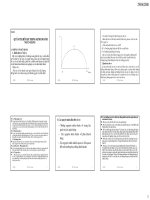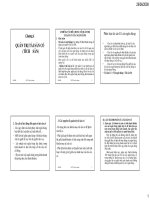slike bài giảng quản trị ngân hàng chương 1 an overview of banking sector
Bạn đang xem bản rút gọn của tài liệu. Xem và tải ngay bản đầy đủ của tài liệu tại đây (381.67 KB, 64 trang )
William Chittenden edited and updated the PowerPoint slides for this edition.
AN OVERVIEW OF
BANKING SECTOR
Chapter 1
Key topics
1. Bank definitions
2. Bank regulation
Goals of regulation
Regulators
Rationality of regulation
3. Bank functions
4. Bank services
5. Bank organization
6. Fundamental sources of changes
1. What is a bank?
Definition by functions it serves
Institutions involves in transferring funds from
savers to borrowers (financial intermediation)
& in paying for goods and services (payment
intermediation)
Definition by services it offers to
customers
Accept deposits, make commercial loans,
offer trust services, manage cash, etc.
What is a bank?
Necessity of a legal definition:
Regulation purpose
Banking service menu is expanding
Other financial-service institution provide
similar services
What is a bank?
Definition by legal basis for regulation
US: any institution that could qualify for
deposit insurance administered by the FDIC
VN (Law of credit institution 2004): a credit
institution permitted to conduct all banking
activities and other related business
operations.
What is a bank?
Definition by legal basis for regulation
VN: "Non-bank credit institution" is a credit
institution permitted to engage in some
banking activities as its regular business, but
not permitted to receive demand deposits and
to provide payment services.
VN: "Banking activities" are monetary
business activities and banking services, the
regular operation of which is the receipt of
deposits and use of that to extend credits,
provide payment services.
Financial service competitors of banks
Savings associations
Credit unions
Money market funds
Mutual funds (investment companies)
Hedge funds
Security brokers and dealers
Investment banks
Finance companies
Financial holding companies
Life and property-casualty insurance companies
2. Goals of bank regulation
Ensure safety and soundness of banks protecting
public’s savings and confidence
Provide an efficient and competitive financial system
Provide monetary stability to achieve national broad
economic goals
Maintain the integrity of the payments system
Ensure equal opportunity and fairness in the public’s
access to financial services
Provide government with credit, tax revenues and
other services
Help sectors that have special credit needs
Banking principal regulatory agencies (US)
Federal Reserve System (FED)
Comptroller of the Currency (OCC)
Federal Deposit Insurance Corporation (FDIC)
Department of Justice
Securities and Exchange Commission (SEC)
State Boards of Commissions
Banking principal regulatory agencies (VN)
State Bank of Vietnam (SBV)
Deposit Insurance of Vietnam (DIV)
Ministry of Finance (MOF)
State Securities Commission of Vietnam (SSC)
Why banks are closely regulated?
Banks are among leading repositories of public’s
savings
Bank’s power of creating money in form of
readily spendable deposits
Banks provide individuals and businesses with
loans for consumption and investment, which
should be equally and adequately supplied.
Government rely upon banks in conducting
economic policies, collecting taxes and
dispensing government payment.
Shortcomings of restrictive bank regulation
May encourage monopoly due to conditional entry
Does not prevent bank failure
Cannot eliminate economic risk
Does not guarantee that bank management will
make good decisions, but create a struggle
between regulators and banks going on definitively
Less-regulated business win customers away from
more-regulated banks.
The Federal Reserve System
The Federal Reserve System
Fundamental Functions
Conduct monetary policy
Provide and maintain the payments system
Supervise and regulate banking operations
Organization
Board of Governors
12 Federal Reserve District Banks
State Bank of Vietnam
The Federal Reserve System
Monetary Policy Tools
Open Market Operations
Open market purchases (sales) increase
(decrease) reserves & the money supply
Discount Rate
Decreasing (Increasing) the discount rate
makes bank borrowing less (more)
expensive, which leads to an increase
(decrease) in the money supply
Reserve Requirements
Decreasing (Increasing) reserve requirements
increases (decreases) the money supply
3. Commercial banks and the economy
-Bank functions
Banks are the primary conduit for monetary policy
Banks are the primary source of credit for most
small businesses and many individuals
Banks are the major repository of public savings
Banks are the principal operator of payment
system.
4. Traditional services offered by banks
– Bank services
1. Carrying out currency exchange
2. Discounting commercial notes and making
business loans
3. Offering savings deposits
4. Safekeeping of valuables
5. Supporting government activities with credit
6. Offering checking accounts
7. Offering trust services
More recent services offered by banks
– Bank services
8. Granting consumer loans
9. Providing financial advice
10. Managing cash
11. Offering equipment leasing
12. Making venture capital loans
13. Selling insurance policies
14. Selling retirement plans
15. Dealing in securities: brokerage and
investment banking services
Carrying out currency exchange
Bank trade one form of currency to another in
return for fee
Start from early days of banks
Become more complicated in the global financial
market
Be provided by large and well-experienced banks
Discounting commercial notes and
making business loans
Discounting commercial notes/making loans to
merchants based on accounts receivable
Making direct loans for purchasing inventories
of goods (short-term) or for constructing new
facilities (long-term)
Be provided by banks and many other financial-
service competitors
Be the core and main revenue-earning service
of many banks
Offering savings deposits
Be the earliest and major source of fund for
making loan
Compose of many types different in maturity,
form of currency, interest, etc.
Be the most stable funding source
Deposit is subject to reserve requirement and
insurance
Safekeeping of valuables
Keep gold and other valuables of customers in
secure vaults in return for fee
Start since the old days of banks in the Middle
Ages
Supporting government with credit
Banks in Europe during the Industrial Revolution
and in America during the Revolutionary War
had to purchase government bonds with a
portion of deposits.
The custom continues in the modern world
Banks use government bond as a shelter of
liquidity risk and a source of revenue
Offering checking accounts
Demand deposits permit depositors to write
draft/cheque for payment of goods and services
Be one of the most important offerings of the
industry
Service is provided by not only banks but also
credit unions, savings associations, etc.
Today the service is extended to the internet
with the use of smart cards
Provide banks with cheap source of fund.
Offering trust services
Banks manage financial affairs and property of
individuals and firms in return for fee
In property management, banks acts as a
trustee for wills, managing the deceased
customer’s estate,…
In commercial trust department, bank manages
pension plan for businesses and acts as an
agent issuing stocks and bonds.









